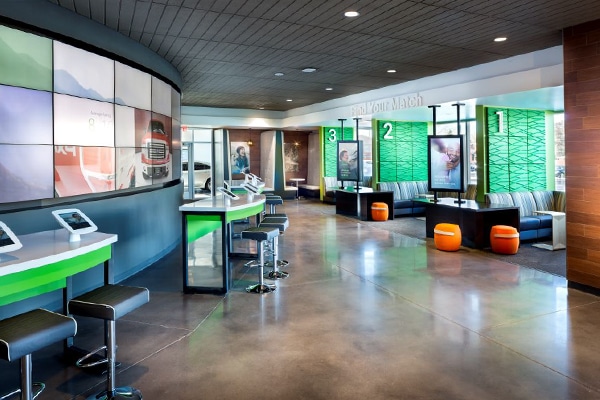
Many car buyers experience a feeling of dread when they walk into a dealership. They worry about remembering the important details they’ve researched ahead of time, as well as the tips from well-meaning friends on how to negotiate the best deal.
More than likely, they don’t notice how the showroom space has been designed to alleviate their discomfort and to offer them the best possible buying experience. But those are the kinds of details Jigna Gopaldas thinks about all the time.
Gopaldas is the design, quality assurance, and quality control manager at Sonic Automotive, one of the largest car retailers in the United States. The company has more than 110 facilities across the South and in California for which Gopaldas oversees the preconstruction and construction design process for renovations, new dealerships, and image updates per brand requirements of the manufacturers Sonic represents. Those responsibilities mean that she grapples with highly tangible elements, like the number of service bays, to intangibles, such as the feel and workflow of showrooms.
“It’s unusual for a car retailer to handle so many design details in-house,” she says. “It saves many outsourcing costs, and it also enables us to create an environment for better customer experiences and to more effectively address objectives that we share with our original equipment manufacturers (OEMs).”

When Gopaldas first interviewed with Sonic three years ago, she immediately recognized the opportunity to create much greater, and more customized, brand awareness. Since then, she has been leading a design transformation that has adjusted Sonic’s old strategy of sole adherence to OEM standards to a strategy that delivers a more tailored guest experience using OEM standards as a baseline.
Gopaldas spent her first fourteen months with the company developing what evolved into Sonic’s own seven hundred-page style book. Using Sonic’s mission to provide unparalleled retail experiences, and its philosophy of “One Sonic, One Experience” as her starting points, she interviewed the heads of nearly every department to get perspectives on what they felt was working and what was not. From there, she developed design standards for every detail, from shop equipment to where thermostats are located. The book now serves as a comprehensive resource for outside vendors that are brought on for any project.

At the same time, Gopaldas began taking an unprecedented stance in response to brand design requirements dictated by the various manufacturers. She characterizes these periodic updates as historically having been somewhat adversarial and creating resentment among dealers because Sonic was being told what to do. She chose to push back by raising questions about the guidelines and offering suggestions that would work better for the dealer—but always as part of a conversation that is searching for common ground that serves the interests of both the dealer and manufacturers.
“My response surprised them a little because few dealer groups had raised issues before about what were essentially cookie-cutter designs,” Gopaldas says. “Their architects know how to create the space and the image they want, but we add value because we know our market and customers, how we prefer to do business, and how to complete construction cost-effectively. Working collaboratively is better for everyone.”

That approach has enabled Gopaldas to explain to Sonic’s leadership and staff how various updates and new requirements will help support ongoing success. She’s also able to customize new designs and renovations. At one Mercedes-Benz dealership, in addition to adding service volume capacity, service intake was streamlined by positioning tablet-equipped staff to greet customers at their cars when they arrived for a more boutique feel.
Gopaldas has been actively involved in developing Echo Park, Sonic’s new network of dealers of previously owned vehicles. Some of that work grew out of research the company conducted into client characteristics and preferences. Sonic examined their target age range, the extent of the research buyers complete before making purchases, how—or if—they want to be greeted when they walk in the showroom door, their overall perception of the buying process, as well as the physical attributes and amenities they prefer. This same information has been applied to Sonic dealerships, as well.

“We examined more emotional research than you might expect,” Gopaldas says. “That led to us developing end-to-end integration in the sales process so that our guests are no longer handed off to a manager or financing expert. All sales associates are trained to handle the complete interaction.”
She goes on to point out that while Sonic itself spawned many ideas for the new brand, Echo Park’s evolution delivered its own lessons. “The buying experience isn’t just about the color choices and the type of furniture,” she says. “It’s the entire layout and how it helps foster personal interactions. The environment and the workflow set the tone for the people who work there, and they’re at the heart of the customers’ experiences.”
Gopaldas loves the problem-solving aspect of her job. The new relationships she’s created with the OEMs give her plenty of opportunities to share solutions to issues they didn’t even know existed: finding a replacement for a discontinued type of required tile or how to work with a metallic paint that was very difficult to apply or maintain. Some of her solutions have even been incorporated into OEMs’ own guidelines, which, ironically, are sent to Sonic’s same-brand competitors.
But the work gives her great satisfaction and the feeling that she’s part of something bigger. “No one can make improvements without feedback,” Gopaldas says. “Maintaining open communication allows me to contribute to better designs and better business outcomes.”


